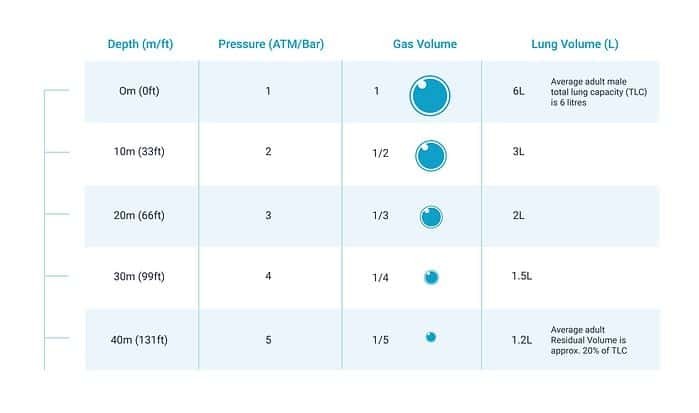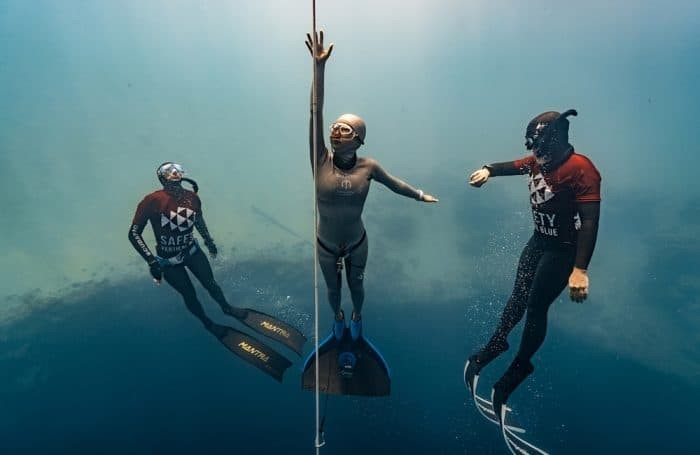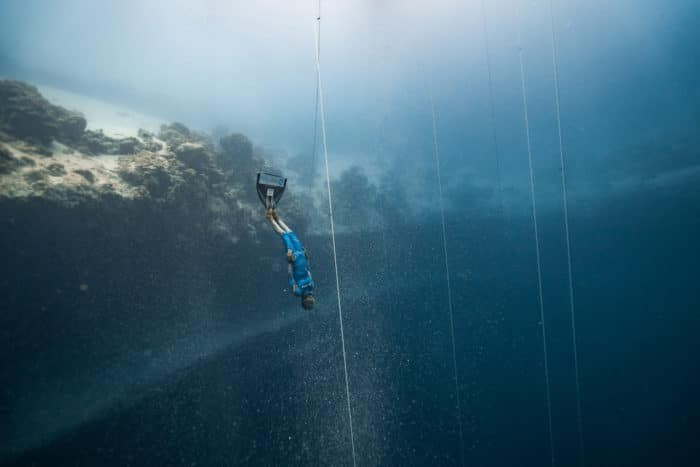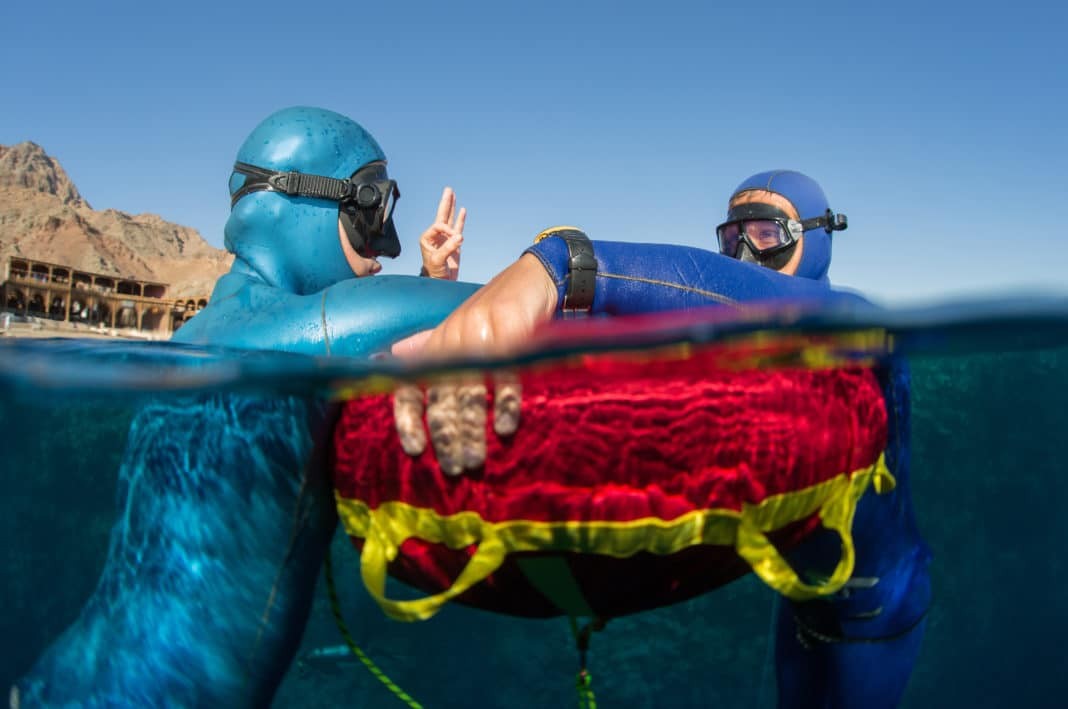In Part 1 of our Complete Guide To Understanding FRC In Freediving: Part 1, we went over the definition of functional residual capacity (FRC), when freedivers can start training FRC, and the science behind how FRC gets freedivers to reach residual volume (RV), or ‘failure depth’ earlier.
We also mentioned that FRC dives should only be incorporated into your dives if you are already diving 30m/98ft or deeper comfortably.
In Part 2, we discuss the many benefits of FRC dives and what they mean on your journey to deeper depths.
Note that freedivers should ONLY attempt their first FRC dives and training under the guidance of a qualified freediving instructor or coach. FRC dives can result in serious injuries if not approached correctly and safely. Self-learned FRC diving through articles or videos is NOT recommended.
What are the benefits of FRC dives?
It is important to remember that FRC dives are only a training aid for your deeper dives. Personal bests (PBs) in FRC dives are somewhat meaningless, especially if performed only once. This is because to reach FRC, you must exhale a certain amount of air – it’s difficult to measure the amount of air you are exhaling and replicate it on every FRC dive. This is why it is important not to chase numbers when diving FRC!
The main two reasons freedivers train FRC are for depth adaptation and training deep equalization using the mouthfill equalization technique, which we discuss further below.
Depth Adaptation
To go deep, our lungs must be flexible enough to withstand the drops in pressure on the way to deeper depths. Look at the Boyle’s Law graphic from the Molchanovs Lap/Wave 1 – Beginner Freediving manual and imagine that the circle under ‘gas volume’ represents your full lungs after taking a full breath.

As you can see, as the surrounding pressure increases, the volume of gas (imagined as our full lungs) is inversely proportional to the pressure exerted by the gas. As we go deeper and experience more surrounding pressure, our lungs will continue to compress accordingly.
As mentioned in Part 1, when we dive FRC, we have half-full lungs. With half-full lungs, the pressure exerted on them at 10m/33ft compresses them to the size that they would be at 30m/98ft if diving with full lungs. So at 20m/66ft, half-full lungs are the same size they would be at 50m/164ft!
This means our lungs must be very flexible to achieve FRC dives to deeper depths. Our diaphragms must be equally flexible to compensate for the negative space that ensues from compressed lungs (which is why uddiyana bandha should be your best friend).
The mammalian dive reflex (MDR) also compensates for negative space from compressed lungs. Peripheral vasoconstriction (when blood vessels in the arms and legs constrict) results in blood shift (blood from the arms and legs shifts to your core), engorging the alveoli in your lungs with blood and increasing them in size, taking up some of that negative space. This is one of the reasons why some deep divers use an FRC dive as a warm-up before their deep dive.
To sum it up, FRC dives and regularly practicing uddiyana bandha train your lung and diaphragm flexibility for deep diving.
Training deep equalization

Mouthfill – every freediver’s favorite (or nightmarish) topic to discuss once they practice it. Mouthfill is a complex equalization technique to learn for most freedivers and is even more challenging to manage at depth. Dry training is a significant component of training mouthfill, but practicing mouthfill in the water will show you what areas need improvement.
However, doing many deep dives past a certain depth in a single session can also be dangerous due to nitrogen accumulation, resulting in decompression sickness (DCS).
Does this mean you can only practice mouthfill equalization in the water a few times in a single training session?
Nope – not with FRC dives!
FRC dives equal shallower depths, which in turn equals less nitrogen build-up. As long as you respect surface intervals, you can do plenty of FRC dives in a session and get in much more mouthfill practice. And since you can go through all the stages of mouthfill in a single FRC dive (depending on how your chest is dealing with the pressure – which should be NONE), you can get some serious insight into which stage of your mouthfill needs improvement.
Remember that no pressure is allowed in FRC dives, which a qualified freediving instructor or coach would control as you are learning.
Trains relaxation and lactic acid adaptation

Diving FRC opens you up to experiencing a lot of potential pressure, so you must learn from an experienced instructor. On FRC dives, your main objective is to remain controlled in your movements and relaxed in your belly, chest, and neck so that your diaphragm can move up and occupy the negative space created by your compressed lungs.
If you are not relaxed, you will start to feel pressure in your chest or throat, in which case you should immediately turn in a controlled manner and avoid jerky movements on your way to the surface (which could result in a trachea or lung squeeze – ouch).
Remember that the golden rule in FRC dives is that NO pressure is allowed.
Blood shift is especially strong on FRC dives. You can use this to your advantage by working on your adaptation to lactic acid. Lactic acid build-up causes that heavy, burning feeling in your legs during CWTB/DYNB or in your arms during FIM (or if you’re a lover of no-fins – BOTH)!
This feeling, usually occurring on deep dives, is replicated on your FRC dives since your blood shift is hard at work. So as you find yourself getting that heavy-leg feeling from FRC, push through it and take the opportunity to push that lactic acid threshold forward!
What’s next?
In Part 3 of our Complete 3-Part Guide to Understanding FRC in Freediving, we’ll highlight things you need to be aware of on your FRC dives.
Stay tuned!
Additional Contributions from Apnea Bali

